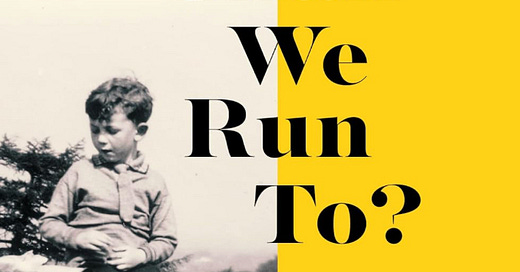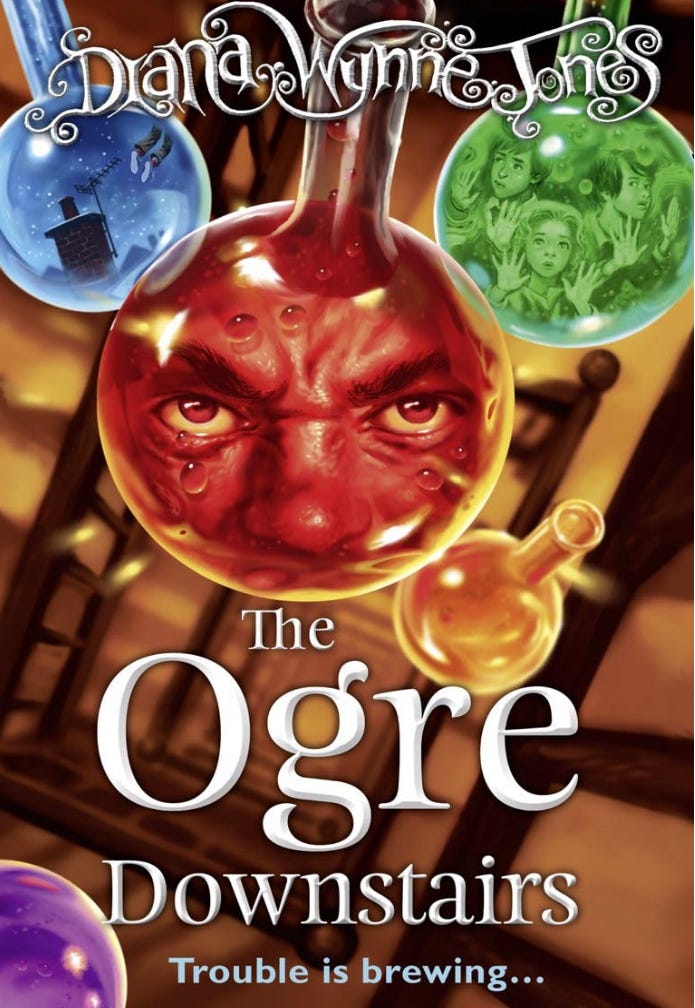How we homeschooled today #112
India, Greek numbers, board games, library books.
It’s back! You can find all previous How We Homeschooled Today posts here. For new readers, my daughter is 9 (Year 4/3rd grade)and my son is 7 (Year 2/first grade).
Monday
First to wake up, my son read The Ogre Downstairs by Diana Wynne Jones. He says it’s the best book he’s ever read—and this boy loves his books. Amazon says 9+, but my son confirms it’s not scary, so younger confident readers should be fine.
On Sunday afternoon I’d been looking at my planning folder and idly asked the children what they remembered about the Agricultural Revolution, which we learnt about several months ago. They both looked at me blankly, and did eventually give me some answers, but were both greatly affronted that I would ask them work-related questions on a Sunday. Their father said they should be being tested regularly on their learning, because testing helps embed learning in our memory. (See this from
if you’re interested.) As the children are only 7 and 9 I’m somewhat ambivalent about this—we do revise learning, and I often ask the children to tell me in their own words what we’ve covered, but written tests is a whole new thing.Anyway, on Monday morning the children came to me and requested weekly written tests. I was suspicious, and rightly so—it turns out they want written tests because they think that means I will no longer randomly ask them about their learning on Sunday afternoons. Anyway, I am now keeping a record of testable facts they learn so that I can prepare written tests.
We aim to start work at 9am because if we don’t, the day slips through our fingers. Spelling on Monday was slightly derailed by the children asking about the latest news from Ukraine, and about what they’d heard on the radio that morning about tear gas and rubber bullets being fired on protesters in LA. They asked if we could buy a newspaper later to learn more.
Spelling consisted of 20 minutes with Schonell (I wrote about it here), and the list of common exception words appropriate for each child’s age. I have noticed huge improvements now that we do spelling as a standing item most days. On the other hand, I have also noticed that my daughter, now 9, has reached a point where she just seems to absorb correct spellings with virtually no effort. When I looked at the list of spellings for years 3 and 4 at the start of the year my heart sank—she was miles away from managing them and it felt completely unachievable. But now she seems to know many spellings without being formally taught, and when she encounters a new one she only has to read it once to know it. Daily practice helps, but so does reaching some invisible developmental milestone that means these things suddenly come more easily. As so often in parenting, I wish I’d known that the children would get there eventually—maybe one day I’ll learn!
Spelling was followed by a few minutes of Multiplication by Heart (UK link/US link), a flash card system for learning multiplication facts. We have been doing it for years, and I highly recommend it. We’d returned to it recently because I noticed the children were getting a bit rusty on some of their facts, so we’re just racing through and practising the tricky ones.
Then my son worked in his handwriting book while my daughter did some work on angles in her maths workbook. I’m trying to encourage her to do maths independently, with assistance from me when she needs it—this is a new skill and it doesn’t always work! The handwriting book is different to any others I’ve seen—it focuses on developing the skills required for handwriting, not just on handwriting itself. So initially there aren’t any letters to write, just lots (and lots) of pen control exercises. We just do 5-10 minutes a day. I like it because, frankly, if writing letters over and over again was going to improve my son’s writing, he’d be a professional calligrapher by now. The book (in fact books—they come as a set) is expensive, but I feel it is excellent value. I’d recommend it both for children just starting to write and for older children for whom handwriting is a nemesis struggle. Unlike many handwriting books, it doesn’t have an age written on the cover, so no child has to feel they’re using a book for babies.
All that took fifty minutes, so then we took a 20 minute break.
But when we gathered again to read some history the children discovered they were hungry, so the 20 minute break stretched while they spread yoghurt all over the kitchen got themselves a snack.
History was reading about the British in India from the Usborne Encyclopedia of World History. We also talked about the Silk Road, and about how communication/trade routes have often also been routes for disease as well as goods and people—the Silk Road transmitted the plague from Asia to Europe. Last week we visited the replica of Columbus’s ship and revised previous learning about the Europeans landing in the Americas, and we talked about the exchange of goods—and disease—which this began. So turning our attention eastwards but on similar themes built on familiar ground.
Last week we had learnt about Africa’s Great Green Wall, and I wanted the children to do some map work to cement that learning. They shaded maps of Africa to show the Sahara and the Sahel, and they then got quite into it and added rainforest further south. We looked at various climatic maps of the continent and noticed that climates are arranged symmetrically around the Equator. I hope to develop this later in the week, although I’m not sure how well I can simplify it for young children whilst still retaining sensible facts—suggestions welcome!
We then looked briefly at Telling Tales in Greek (which we have moved onto having finished Basil Batrakhos—thank you
for the recommendation), which was about Greek numbers and how many ships were sent to reclaim Helen in the Iliad. It’s fair to say the children had had enough by this point, so we will revisit Greek numbers later in the week.I read them the new poem I want them to learn—The Lobster Quadrille by Lewis Carroll—and we had a go at learning the first two lines. But later both said they didn’t enjoy it at all, so we’ll probably switch to something different later in the week.
The afternoon was taken up with a library trip. We borrowed:
Children’s choices: Usborne Young Reading Macbeth, Hamlet, Canterville Ghost, Christmas Carol (do not adjust your calendars, it is indeed June), Ali Baba. The Mysterious Adventures of Sherlock Holmes. The Dragon Tattoo (Sherlock Holmes-inspired, and written for children).
My choices: The Girl Who Rowed the Ocean, How To Train Your Dragon, The Georgians, The Victorians (both Usborne History of Britain series), The Element in the Room (chemistry—this made my son laugh so much today that he had to leave the room to recover himself), Professor Astrocat’s Atomic Adventure (physics—there’s a whole series on different science topics), What’s Chemistry All About?, Meet the Microbes, How Was That Built?, Avoid Being on Apollo 13!
I also borrowed Alan Garner’s memoir, Where Shall We Run To?, for myself. I had read 120 pages by the time I went to sleep—it’s a really good book. I’m especially enjoying reading about a childhood, in this country and not so very long ago (Garner is now 90), that is so, so different from my own children’s experience. And things weren’t always better in the past—by the age of 8 Garner had had diphtheria, meningitis, double pneumonia with pleurisy, and a bout of whooping cough and measles simultaneously. It’s both funny and sad. Recommended.
We bought a newspaper to read about Ukraine and the LA protests. I said I would find suitable articles for the children, because much of what’s in the papers is not intended to be read by small people. But I couldn’t find a single article about Ukraine in the whole paper. We did look at the photos from LA. They will have to continue to eavesdrop on the morning radio news until I find a more informative edition.
When we got home we played Azul and Forest Shuffle (both favourites in this house), and I read aloud most of a Sherlock Holmes story. My daughter found the beginning of it incomprehensible when she read it to herself, but could mostly understand it when it was read to her. Sentences like this are quite challenging to the typical nine year old:
Some, too, have baffled his analytical skill, and would be, as narratives, beginnings without an ending, while others have been but partially cleared up, and have their explanations founded rather upon conjecture and surmise than on that absolute logical proof which was so dear to him.
Also this:
It was in the latter days of September, and the equinoctial gales had set in with exceptional violence. All day the wind had screamed and the rain had beaten against the windows, so that even here in the heart of the great, hand-made London we were forced to raise our minds for the instant from the routine of life, and to recognise the presence of those great elemental forces which shriek at mankind through the bars of his civilisation, like untamed beasts in a cage.
Throw in explanations about pince nez, toe caps, coroners’ verdicts etc, and one short story can prove very educational indeed!
Reading in bed: More of The Ogre Downstairs, and whatever book in the Murder Most Unladylike series my daughter is currently tearing through.
Thanks for reading. If you’re not subscribed to How We Homeschool, sign up for free and never miss a post.






Do you use the teaching book that goes alongside the schonell list? I too have a struggling hand writer and we're using speed it up by the same author of the handwriting program you're using. Really hoping it helps him. Thanks for sharing.
Thanks for sharing a glimpse at your day! I find these so helpful to see how others integrate subjects, especially with science, geography, and history. Bookmarking a few of your recommendations, like the multiplication flash cards and other books you mentioned. Reading more classics aloud to my kids is something I'm becoming much more intentional about...they need to hear it first (and hopefully enjoy it) before I can expect them to be drawn to it themselves.